Furuno USA 9ZWRTR091 Marine Radar User Manual
Furuno USA Inc Marine Radar
Contents
- 1. user manual part 1
- 2. user manual part 1a
- 3. user manual part 2
- 4. user manual part 3
- 5. install manual
user manual part 2
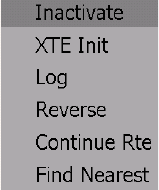
Chapter 2: Chart Plotter Operation
2-18
Stop following a point
You can stop following a point in two ways: select the point directly on the screen, or
select the Points and Stop ROTOkeys.
1. Use the Cursorpad to select the point you want to stop following.
2. Push the right-button key to show the Points pop-up menu.
3. Rotate the Rotary Knob to select Inactive and push the Rotary Knob.
The dotted line from own vessel to the point is erased from the screen. If you want to
once again follow the point:
1) Select the point on the screen.
2) Open the Points pop-up menu.
3) Choose Go To and push the Rotary Knob.
Navigation is then restarted from the point at which it was stopped.
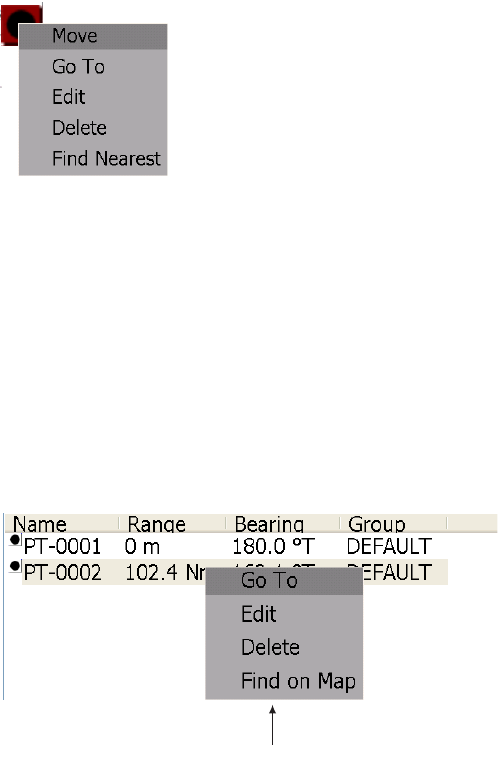
Chapter 2: Chart Plotter Operation
2-19
Moving a Point
You can move a point two ways:
• Drag its symbol to a new location
• Enter new position manually on the Points list
Moving a point on screen
1. Set the cursor on the point you wish to move. When the point is correctly selected
it is magnified.
2. Hit the right-button key to show the point pop-up menu.
Point pop-up menu
3. The cursor is selecting Move; push the Rotary Knob.
4. Using the Cursorpad, drag the symbol to new location and push the Rotary Knob
to fix the point symbol to the new location.
Moving point position at the Points list
1. Long-push the GO TO/LIST key to open the Alpha list.
2. Rotate the Rotary Knob to choose the point to edit and push the Rotary Knob.The
Point edit pop-up menu appears and the screen is split in halves, with the chart on
the right zoomed to show location of point.
3. Rotate the Rotary Knob to select Edit and push the Rotary Knob. The chart is then
replaced with the point’s attributes and details.
4. The cursor is selecting the Position combo box. Push the Rotary Knob.
5. Enter position as follows:
1)Rotate the Rotary Knob to display latitude degree desired and push the Rotary
Knob.
2)Push the Rotary Knob and the cursor jumps to latitude minutes thousandths/
hundreds place. Rotate the Rotary Knob to display desired value and then
push it.
3)The cursor is now selecting the latitude minutes tens/ones place. Push the
Rotary Knob. Rotate the Rotary Knob to display desired value and then push it.
Waypoiint list pop-up menu
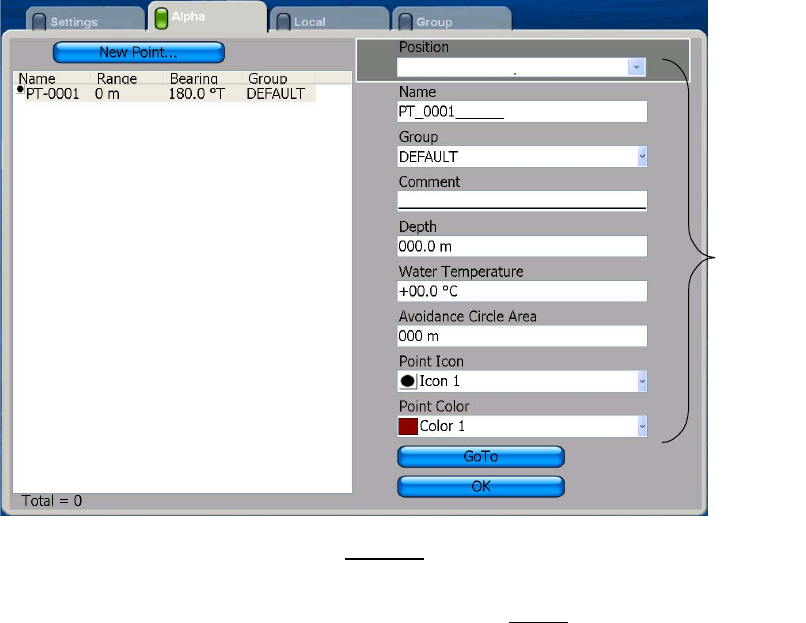
Chapter 2: Chart Plotter Operation
2-20
4)The cursor is on the position coordinate, N or S. Rotate the Rotary Knob to
switch coordinate to N or S or vice versa and then push it.
5)The cursor is now on the longitude field. Use the Rotary Knob to enter longi-
tude, similar to how you entered latitude.
6. Rotate the Rotary Knob to choose the OK button on the display and then push the
Rotary Knob.
Editing Attributes and Details for a Point
You can choose the point to edit in two ways:
• Use the cursor to select the point on screen
• View point data on the Points list
1. Do one of the following to display the Points list:
1)Choose the point on the screen and push the right-button key, or
2)Open the Points menu and then select the Alpha Points list.
2. Push the Rotary Knob to put the cursor in the Points list.
3. Rotate the Rotary Knob to select the point you want to edit.
4. Push the Rotary Knob to show the point Edit pop-up menu.
5. Rotate the Rotary Knob to choose Edit and push the Rotary Knob. Then, the
point’s attributes and details appear on the right-halve of the screen.
6. The cursor is selecting the Position combo box. If necessary, push the Rotary
Knob and enter position, referring to section 2.4 for the procedure.
7. To change the name of the point, select the Name box. Change the name as fol-
lows:
1)Push the Rotary Knob consecutively to select location (character) to edit and
push the Rotary Knob. (To clear a line of data, use the Rotary Knob.)
2)Rotate the Rotary Knob to select desired alphanumeric character and push
the Rotary Knob.
01°12.9158'S; 000°30.9755'W
Waypoint
attributes
and details
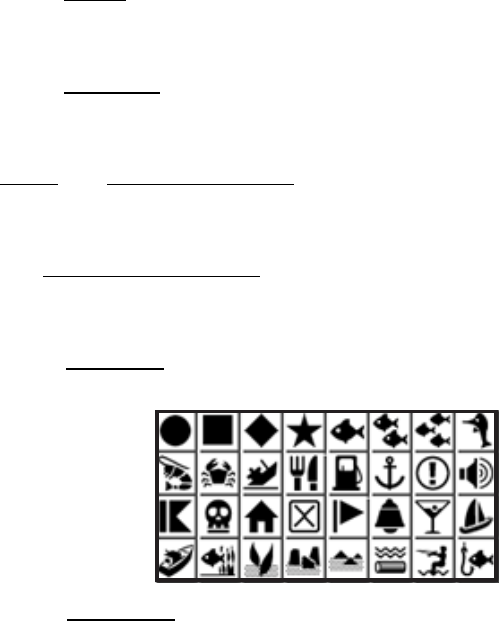
Chapter 2: Chart Plotter Operation
2-21
3)Repeat steps 1 and 2 to complete the name. A name can have up to 32 alpha-
numeric characters.
8. Select Group if you have some groups registered and you want to put this point
into one of those groups. Choose the name of the group from the combo box and
push the Rotary Knob.
9. Select Comment to provide a comment about the point. A comment is entered in
the same manner as Name. You can use up to 32 alphanumeric characters for a
comment.
10.Depth and Water Temperature are the depth and water temperature of the loca-
tion at the time of entry. Applicable sensors are necessary to display this data. If
necessary you can change this data.
11.Use Avoidance Circle Area to specify the distance to use for the proximity alarm,
which alerts you when own ship is within "x" miles from a point. For details about
the proximity alarm, see the section on alarms.
12.Select Point Icon if you want to change the point symbol for the point selected, 32
symbols are available.
13.Select Point Color to change the color of the square in the point symbol. Seven
colors are available: red, yellow, green, light blue, purple, dark blue, and gray.
14.To finish, select the OK button and push the Rotary Knob.
Finding a Point on a Map
You can easily find the position of a point on your map from the Alpha list.
1. Long-push the GO TO/LIST key to show the Alpha list.
2. Choose the point and push the Rotary Knob. The Points list pop-up menu
appears.
3. Rotate the Rotary Knob to choose Find on Map and then push the Rotary Knob.
4. The menu is closed and the full-screen map window appears, with the point
selected at the center of the map.
Finding Nearest Port from a Point
You can easily find the port nearest a point as follows.
1. Put the cursor on the point from which you want to know where the nearest port is
located.

Chapter 2: Chart Plotter Operation
2-22
2. Push the Rotary Knob to show the Points pop-up menu.
3. Rotate the Rotary Knob to select Find Nearest and push the Rotary Knob.
Deleting a Point
A point can be deleted two ways: on the screen and from the Points list.
Deleting a point on the screen
1. Put the cursor on the point to delete.
2. Push the right-button key to show the Points list pop-up menu.
3. Rotate the Rotary Knob to select Delete and push the Rotary Knob to delete the
point.
The point is deleted from both the screen and the Points list.
Deleting a point at the Points list
To delete a point on the Points list:
1. Long-push the GO TO/LIST key to show the Alpha list.
2. Select the point to delete and push the Rotary Knob. The Points list pop-up menu
appears.
3. Rotate the Rotary Knob to select Delete and push the Rotary Knob to delete the
point.
The point is deleted from both the screen and the Points list.
Deleting All Points
All points may be deleted. A points currently being followed cannot be deleted.
1. Press the MENU key to open the menu.
2. Open the Points menu.
3. Open the Settings sub menu.
4. Choose Delete All Points and push the Rotary Knob. You are asked to confirm if
you are sure to delete all points.
5. Rotate the Rotary Knob to choose Yes and push the Rotary Knob.
Chapter 2: Chart Plotter Operation
2-23
Globally Showing, Hiding Points
All points can be globally shown or hidden. A point which is currently being followed
cannot be removed from the screen until following is stopped.
1. Long-push the Rotary Knob to show the ROTOkeys.
2. Choose Points and push the Rotary Knob.
3. Choose Points and push the Rotary Knob to alternately show and hide all points.
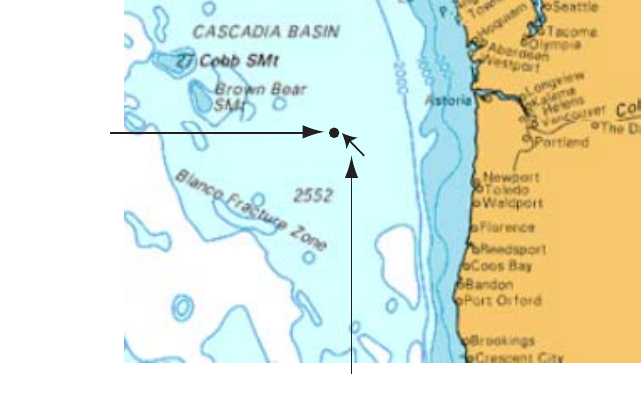
Chapter 2: Chart Plotter Operation
2-24
2.13 Routes
Often a trip from one place to another involves several course changes, requiring a
series of route points (up to 100) which you navigate to, one after another. The se-
quence of points leading to the ultimate destination is called a route. The route data-
base stores 200 routes.
You create a route by pointing and clicking locations route points on the screen. Route
points are marked with solid blue circles in the default setting. If desired you can mark
route points with points. This can be done from the Routes menu.
Once you have created a route you can follow it, using the GOTO feature. When you
follow a route, the current leg is shown as a dotted line and previous legs are erased
from the screen. (points remain on the screen if route points are marked with point
symbols.)
• On-screen routes can easily be edited by displaying the Routes pop-up menu. With
the pop-up menu, you can
• Insert a point
• Activate a route
• Reverse route direction
• Split the result
• Find details about the route
• Delete a route
• Add new point(s) at the end or beginning of a route
• Skip a route point when following a route
• Find nearest port, etc.
Creating a New Route
In the default setting, route points are marked with a blue circle. Alternatively, you can
enter them as points, saving each point to the Points list. For details see "Entering
route points as waypoints" on the next page.
1. Long-push the POINTS/ROUTE key. (The ROTOkeys Route and New also
enable route creation.) The route point placement cursor appears together with
the cursor.
Cursor
Route point
placement
cursor
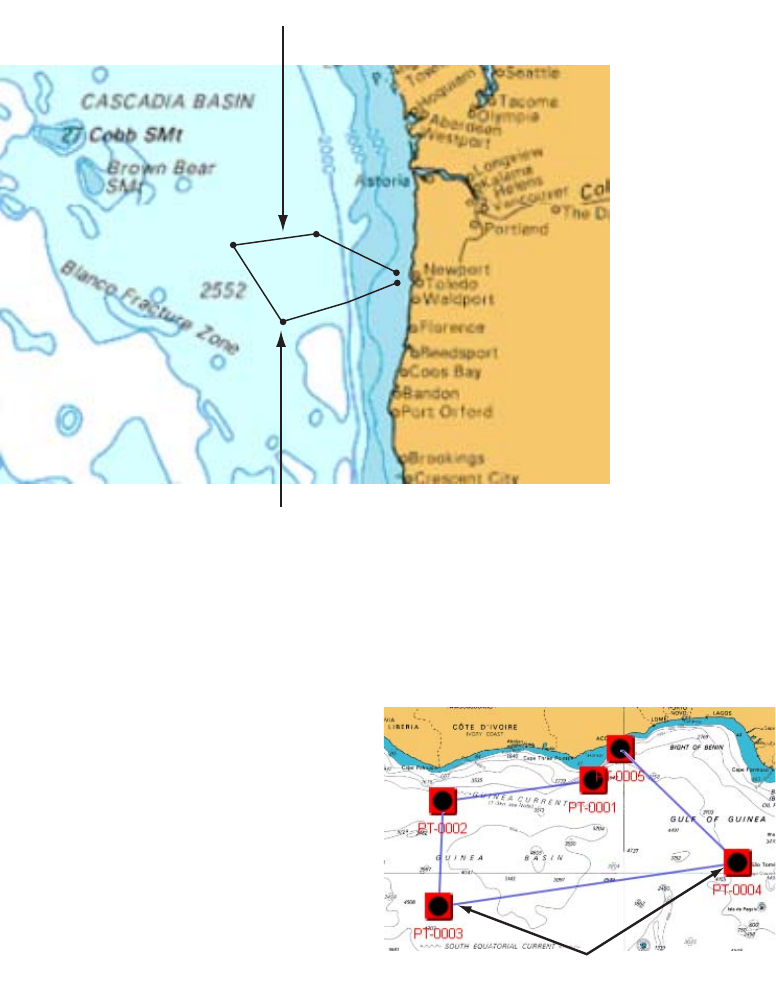
Chapter 2: Chart Plotter Operation
2-25
2. Place the cursor on the 1st point of the route and hit the left-button key or right-
button key.
3. Use the cursor to drag the placement cursor to next point in the route. As you do
so, a dashed line extends from the origin to the cursor location.
4. Press the left-button key or right-button key. The line between the first point and
second point is now solid.
5. Drag the placement cursor to the next point in the route and press the left-button
key or right-button key. Repeat this step to enter all route points.
6. At the final route point, push the Rotary Knob to complete the route and save it to
the route database. All segments in the route are connected with a solid line.
The route is saved to the route list under the youngest empty point number, with the
prefix "RTE-". A solid blue line runs between route points and blue dots mark route
points.
Entering route points as waypoints
In the default setting route points are
marked with a solid circle. If desired, you
may enter route points as points. Any
route point entered is saved to the Points
list as a point, under the youngest empty
point number.
1. Press the MENU key to open the
menu.
2. Open the Routes menu.
3. Open the Settings sub menu.
4. Use the Rotary Knob to choose Create True Erupts when Building Re.
5. Push the Rotary Knob to color the square green to enter route points as points, or
gray to enter them as simple route points.
6. Press the Rotary Knob to close the menu.
Route leg (blue)
Route point (blue)
Points
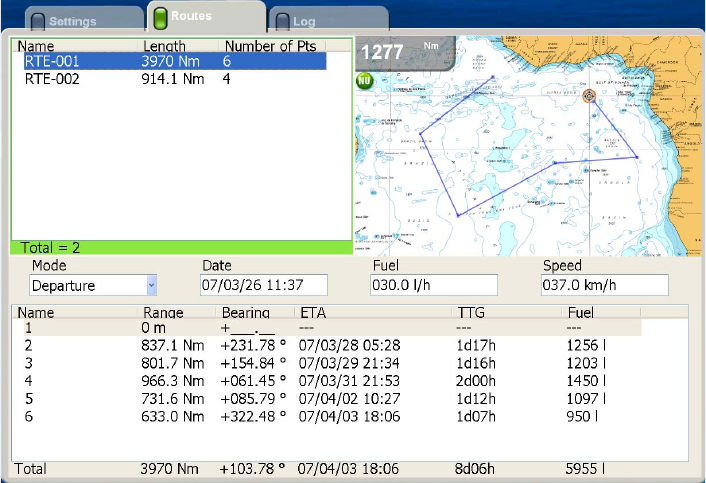
Chapter 2: Chart Plotter Operation
2-26
Route List
Saved routes are stored in the Route list. The list stores the following route data for
each route:
• Name of route
• Length of route
• Number of route points
• Range between legs
• Bearing between legs
• Length between legs and total length
• ETA between legs and total ETA
• TTG between legs and total TTG
• Fuel consumption both between legs and total
To show the Route list, do as follows:
1. Press the MENU key to open the menu.
2. Open the Routes list.
3. Push the Rotary Knob to put the cursor in the Route box.
4. Rotate the Rotary Knob to choose the route to view and push the Rotary Knob.
5. Press the MENU key to close the menu.
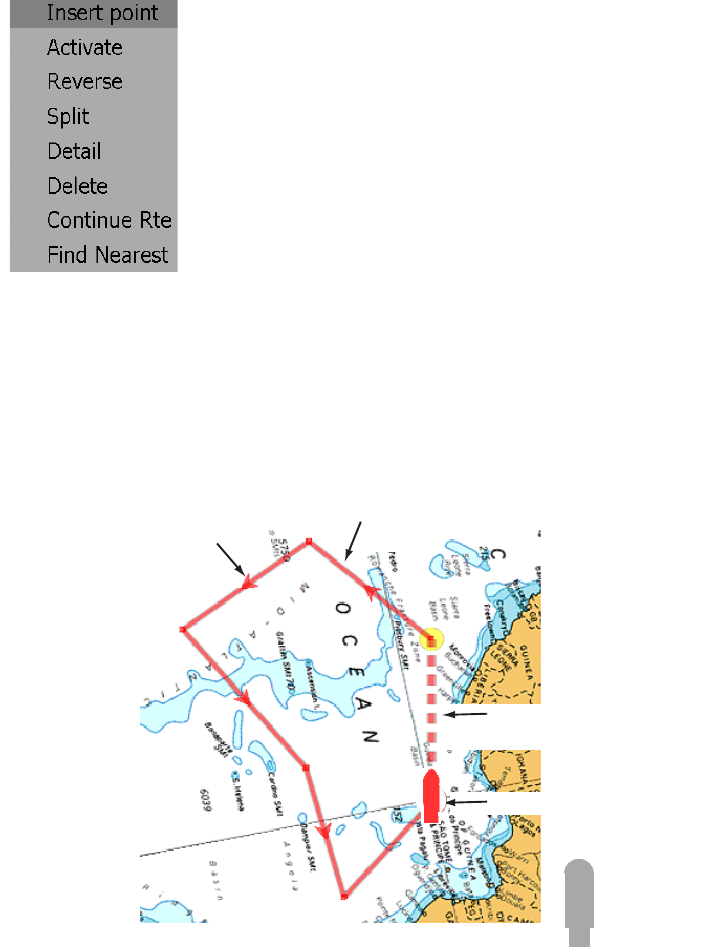
Chapter 2: Chart Plotter Operation
2-27
Following a Route
Before attempting to follow a route, you should first check that the path along the way
is safe. Be sure to zoom your chart to check for hazards which might not appear on a
smaller scale.
Selecting a Route Currently Displayed
1. Put the cursor on a leg of the route to follow and push the right-button key to
show the Route pop-up menu.
2. Rotate the Rotary Knob to choose Activate and push the Rotary Knob.
When a route currently displayed is selected to follow:
• The course-up mode is automatically selected.
• The color of all route legs changes from blue to red and a dashed line runs between
current position and 1st route point.
• Arrows pointing in the direction to follow the route are placed on the route.
Route leg (red line)
Current position
Course to 1st route point
(red dashed line)
Arrow points in direction
to follow route
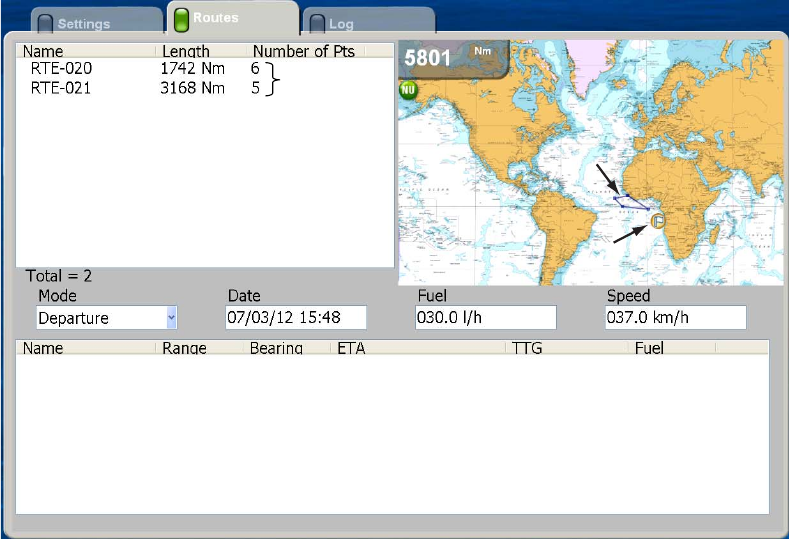
Chapter 2: Chart Plotter Operation
2-28
Selecting a Route from the Routes List
1. Press the MENU key to open the menu.
2. Open the Routes menu.
3. Open the Routes sub menu.
4. Choose a route and push the Rotary Knob to show the Route pop-up menu.
5. The cursor is selecting Activate; push the Rotary Knob.
When you select a route to follow at the Routes list:
• The course-up mode is automatically selected.
• The route legs are red and red dashed line connects between current position and
1st route point.
• Arrows on the route show the direction in which to follow the route.
Saved
routes
Route
Other route
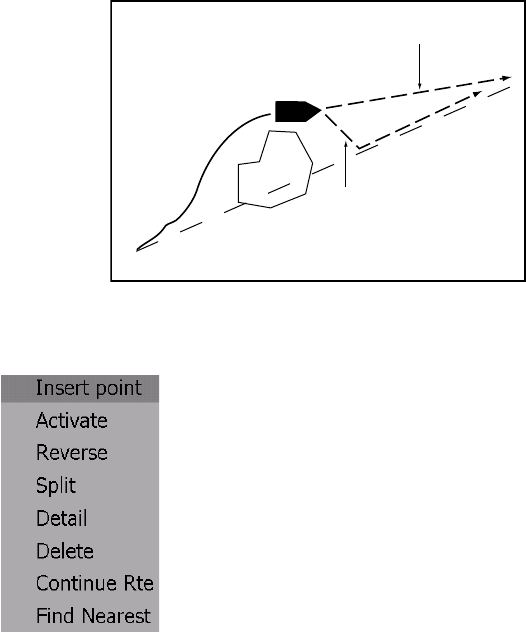
Chapter 2: Chart Plotter Operation
2-29
Route Follow Options
Restarting XTE
While you are following a point, you can restart the XTE. This will reset the XTE to zero
and restart XTE from actual position.
When you steer to avoid an obstacle or the vessel drifts, you may go off your intended
course, as in Line 1 in the figure below. If you don't need to return to the original
course, you can go directly to point, as in Line 2 in the figure below.
1. Put the cursor on the current leg and push the right-button key to show the Route
pop-up menu.
2. Rotate the Rotary Knob to choose XTE Init and push the Rotary Knob.
The route origin shifts to current position. You can also restart XTE by using the
Routes-XTE ROTOkey.
Reversing following direction
The current route can be followed in reverse. This is useful when you have decided
not to follow the entire route in the original direction and want to return to point of origin
via the same route.
1. Put the cursor on the current leg of the route.
2. Push the Rotary Knob to show the Routes pop-up menu.
3. Rotate the Rotary Knob to choose Reverse and push the Rotary Knob.
You can also reverse following direction by selecting the Route and Reverse ROTOk-
eys.
Original course
Obstacle Line 1
Line 2

Chapter 2: Chart Plotter Operation
2-30
Stop following a route
You can stop following a route in two ways: select the route directly on the screen, or
select it at the Routes list. Below is the method for selecting the route on the screen.
1. Use the Cursorpad to select the route you want to stop following.
2. Push the Rotary Knob to show the Routes pop-up menu.
3. Rotate the Rotary Knob to select Inactive and push the Rotary Knob.
You can also stop following a route by selecting the Routes and Stop ROTOkeys.
Route point switching mode
When you arrive to a route point on a route, you can switch to the next point by one of
the three methods below.
Perpendicular: Automatically switch the destination point when the boat passes
an imaginary perpendicular line passing through the center of the destination
point, or the boat comes within the arrival alarm range.
Circle: Destination point is automatically switched when the boat comes within the
circle.
Perpendicular and Circle: Destination point is automatically switched when
either of the perpendicular or circle condition above is satisfied.
1. Press the MENU key to open the menu.
2. Open the Routes menu.
3. Open the Settings sub menu.
4. Choose Waypoint Switching Mode and push the Rotary Knob.
5. Choose appropriate option, referring to the description above, and push the
Rotary Knob.
6. If you choose Circle or Perpendicular and Circle, choose Switching Mode Circle
Value and push the Rotary Knob.
7. Enter the distance from a route point at which to switch to next point and push the
Rotary Knob.
8. Press the MENU key to close the menu.
Route auto zoom
Range can be automatically changed to show the next point after passing current
point. This is useful for locating the next point without changing the range.
1. Press the MENU key to open the menu.
2. Open the Routes menu.
3. Open the Settings sub menu.
4. Choice Route Auto Zoom and push the Rotary Knob to turn on or off as desired.
5. Press the MENU key to close the menu.
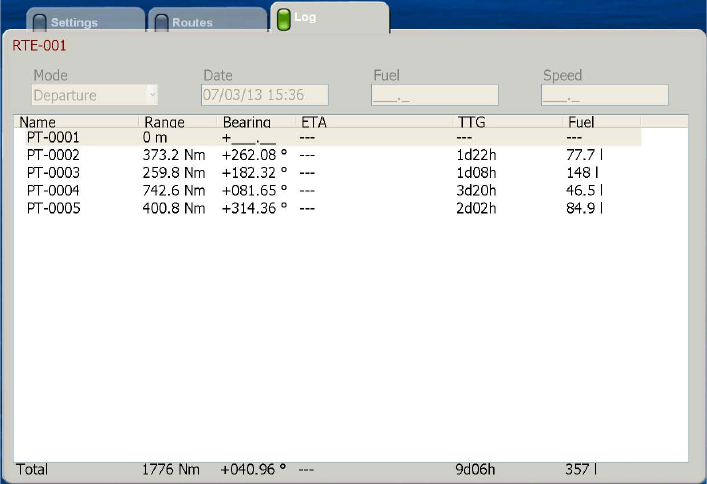
Chapter 2: Chart Plotter Operation
2-31
XTE alarm display on chart
You may digitally show the XTE alarm value (set on the Alarm menu) at both sides of
the route.
1. Press the MENU key to open the menu.
2. Open the Routes menu.
3. Open the Settings sub menu.
4. Choice XTE Alarm DIsplay upon Chart and push the Rotary Knob to turn on or off
as desired.
5. Press the MENU key to close the menu.
Route Log
The route log provides a convenient means for monitoring progress in a route. The log
shows
• Range between route points
• Bearing between route points
• ETA to each route point
• TTG to each point
• Estimated fuel consumption between route points.
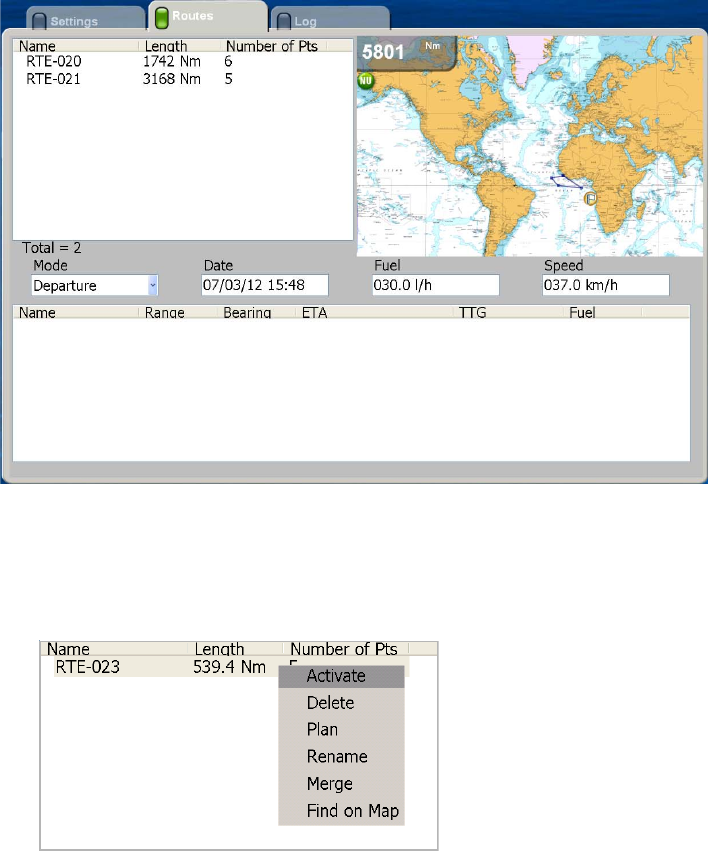
Chapter 2: Chart Plotter Operation
2-32
Reviewing Passage Plan
A navigation calculator is provided to help you plan navigation. You can set date of
departure or arrival, amount of fuel to use and projected speed. Your unit then calcu-
lates ETA, TTG and fuel consumption.
1. Press the MENU key to open the menu.
2. Open the Routes list on the Routes menu.
3. Push the Rotary Knob to put the cursor in the Route box.
4. Rotate the Rotary Knob to choose the route for which you want to review its pas-
sage plan.
5. Push the Rotary Knob to show the Route list pop-up menu.
Saved
routes
Route
Other route
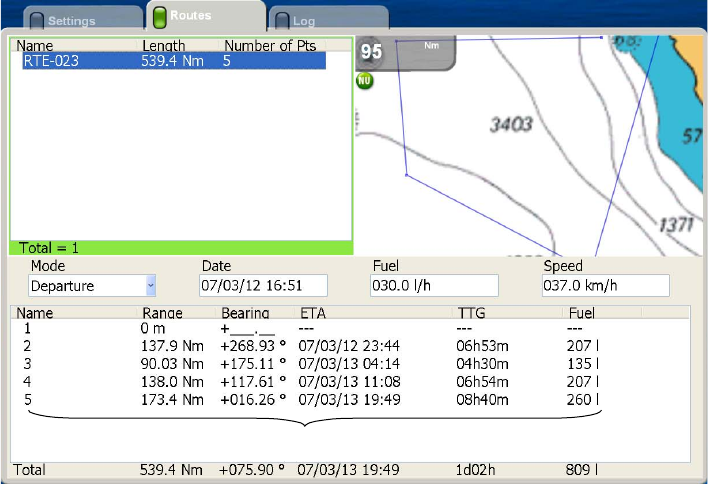
Chapter 2: Chart Plotter Operation
2-33
6. Rotate the Rotary Knob to choose Plan and push the Rotary Knob.
The cursor is selecting the Mode combo box.
7. Push the Rotary Knob to show the options for Mode.
8. Select Departure or Arrival as applicable and push the Rotary Knob.
9. Rotate the Rotary Knob to select the Date input box and push the Rotary Knob.
10.Enter date and time of departure (or arrival) and push the Rotary Knob.
11.Rotate the Rotary Knob to select the Fuel input box and push the Rotary Knob.
12.Enter estimated fuel consumption (liters per hour) and push the Rotary Knob.
13.Rotate the Rotary Knob to select the Speed input box and push the Rotary Knob.
14.Enter speed (kilometers per hour) and push the Rotary Knob.The route data at the
bottom of the screen changes accordingly.
15.Press the MENU key to close the menu.
Route data and calculations
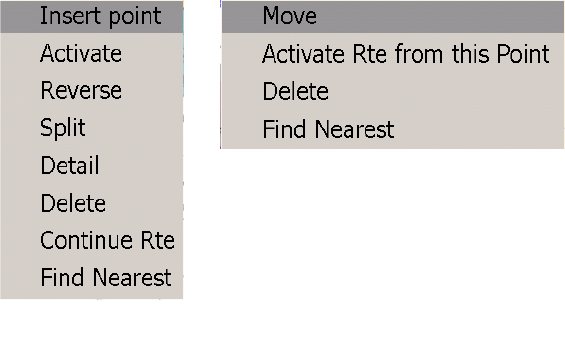
Chapter 2: Chart Plotter Operation
2-34
Editing a Route On-screen
A route currently displayed on-screen can be edited by opening the Route pop-up
menu. A route point can be inserted and route leg deleted.
1. Put the cursor on the route point or route segment you wish to edit and push the
right-button key. The applicable pop-up menu appears
2. Rotate the Rotary Knob to choose appropriate item.
3. Follow the applicable instructions below.
Editing a route leg
Insert point: Place the cursor on the leg to edit. A dashed line runs between the
two points of the leg. Use the Cursorpad to drag the dashed line to a new location.
Split: This function erases the selected leg.
Delete: Delete the route selected. The route is erased from the screen and deleted
from the route database.
Editing a route point
Move: Drag the point to a new location. Select the point, use the Cursorpad to drag
it to a new location and the push the Rotary Knob.
Delete: Delete the point selected.
4. Push the Rotary Knob to finish.
Route pop-up (route point)
Route pop-up
(route leg)
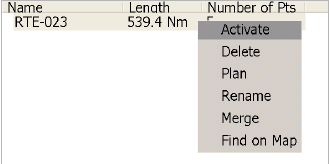
Chapter 2: Chart Plotter Operation
2-35
Finding a Route on a Map
You can easily find a route’s location on your map as follows:
1. Press the MENU key to open the menu and then open the Routes list.
2. Push the Rotary Knob to put the cursor in the Route box.
3. Rotate the Rotary Knob to choose a route.
4. Push the Rotary Knob to show the Route list pop-up menu.
5. Choose Find on Map and push the Rotary Knob.
The menu is closed, and the full-screen map window appears, with the route selected
at the screen center.
Renaming a Route
The default route number is the youngest empty route number (RTE-001 - RTE-200).
1. Press the MENU key to open the menu and then open the Routes list.
2. Push the Rotary Knob to put the cursor in the Route box.
3. Rotate the Rotary Knob to choose the route to process.
4. Push the Rotary Knob to show the Route list pop-up menu.
5. Rotate the Rotary Knob to choose Rename and push the Rotary Knob. The route
renaming box appears.
6. Enter new name and push the OK button.
7. Press the Rotary Knob to close the menu.
Merging Two Routes
Two routes can be merged. The routes are merged with the last route point of the 1st
route selected connected to the 1st route point of the 2nd route selected. The route is
saved under the 1st-selected route’s name and the 2nd route is deleted. All route data
is updated accordingly.
1. Press the MENU key to open the menu and then open the Routes list.
2. Push the Rotary Knob to put the cursor in the Route box.
3. Rotate the Rotary Knob to choose the 1st route.
4. Push the Rotary Knob to show the Route list pop-up menu.
5. Select Merge and push the Rotary Knob.
6. Rotate the Rotary Knob to choose the 2nd route and push the Rotary Knob.
7. Select Merge and push the Rotary Knob.
8. Press the MENU key to close the menu.
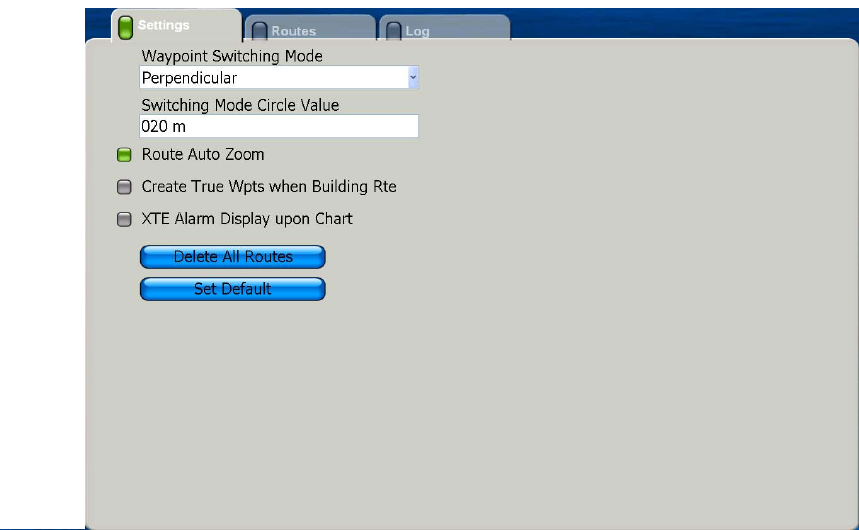
Chapter 2: Chart Plotter Operation
2-36
Deleting Routes
A route may be deleted individually by selecting it on-screen or at the Routes list, or
collectively from the Settings sub menu in the Routes menu.
Deleting on-screen route
1. Put the cursor on the route.
2. Push the right-button key to show the Routes pop-up menu.
3. Rotate the Rotary Knob to select Delete and push the Rotary Knob.
Deleting a Route at the Routes List
1. Press the MENU key to open the menu and then open the Routes list.
2. Push the Rotary Knob to put the cursor in the Route box.
3. Rotate the Rotary Knob to choose the route you wish to delete.
4. Push the Rotary Knob to show the Route list pop-up menu.
5. Select Delete and push the Rotary Knob.
6. Press the MENU key to close the menu.
Deleting all routes
All routes may be deleted. A route currently being followed cannot be deleted.
1. Press the MENU key to open the menu.
2. Open the Routes menu.
3. Open the Settings sub menu.
4. Choose Delete All Routes and push the Rotary Knob. You are asked to confirm if
you are sure to delete all routes.
5. Rotate the Rotary Knob to choose Yes and push the Rotary Knob.
6. Press the MENU key to close the menu.
Chapter 2: Chart Plotter Operation
2-37
Globally Showing, Hiding Routes
All routes can be globally displayed or removed from the screen. A route which is cur-
rently being followed cannot be removed from the screen unless route following is
stopped.
1. Long-push the Rotary Knob to show the ROTOkeys.
2. Choose Routes and push the Rotary Knob.
3. Choose Routes and push the Rotary Knob to alternately show and hide all routes.
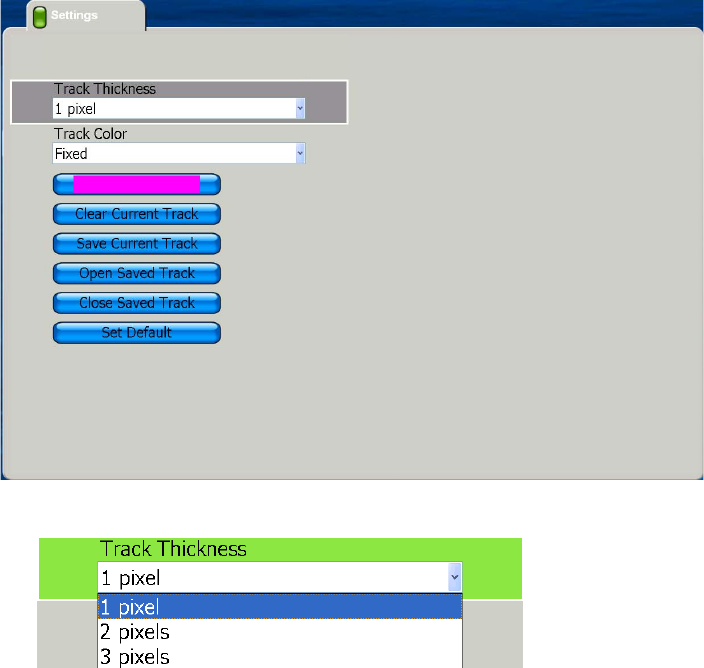
Chapter 2: Chart Plotter Operation
2-38
2.14 Working With Track
Your ship's track is plotted on the screen using position data fed from a navigator, giv-
ing you a graphic presentation of where your boat has been.
The track, if turned on, is temporarily saved to the hard disk in the processor unit. A
line runs between each track point. Up to 12,000 points can be saved. When the ca-
pacity for track points is reached the oldest track points are deleted to make room for
the latest.
Your track remains on screen even if the power is removed. When you no longer re-
quire track you can erase it.
Track can be saved to the memory and one past track displayed at a time. This can
be useful for making a route from past track.
Turning the Track Display On/Off
1. Long-push the Rotary Knob to show the ROTOkeys.
2. Choose Track and push the Rotary Knob to alternately turn track on and off.
Track Thickness
Track thickness can be specified, and the choices are one pixel, two pixels and three
pixels. It can be useful to show your track in the thinnest width if you retrace your track
many times.
1. Press the MENU key to open the menu.
2. Open the Tracks menu.
3. Choose Track Thickness and push the Rotary Knob.
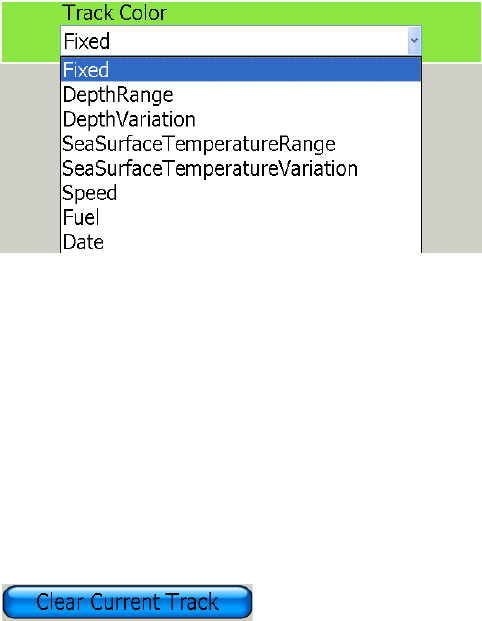
Chapter 2: Chart Plotter Operation
2-39
4. Choose thickness desired and push the Rotary Knob.
5. Press the MENU key to close the menu.
Track Color
Track can be displayed in a single color (default setting) or multiple colors. The choic-
es for single color are red, yellow, green, light blue, purple, dark blue, and white.
For multiple color the track is painted according to
•Depth range
•Depth variation
• Sea surface temperature range
• Sea surface temperature variation
• Speed
• Fuel consumption, or
•Date
To select track color, do the following:
1. Press the MENU key to open the menu.
2. Open the Tracks menu.
3. Select Track Color and push the Rotary Knob.
4. Choose option desired and push the Rotary Knob.
5. Press the MENU key to close the menu.
Clearing Current Track
Current track can be cleared from the display.
1. Press the MENU key to open the menu.
2. Open the Tracks menu.
3. Select Clear Current Track and push the Rotary Knob. If you have not saved the
current track you will be asked if you want to save it.
4. Push the Rotary Knob.
5. Press the MENU key to close the menu.

Chapter 2: Chart Plotter Operation
2-40
Saving Current Track
You can save up to 10 sets of track, to the Track list. Saved tracks can be replayed at
a later date.
1. Press the MENU key to open the menu.
2. Open the Tracks menu.
3. Choose Save Current Track and push the Rotary Knob. You are asked to enter
track name. If desired you can select an existing, in which the previous data will be
written over.
4. Push the Rotary Knob.
5. Press the MENU key to close the menu.
Replaying Saved Track
Saved track can be replayed on the display. This is useful for making a route with a
past track. Note that saved tracks appear together with current track.
1. Press the MENU key to open the menu.
2. Open the Tracks menu.
3. Choose Open Saved Track and push the Rotary Knob.
4. Choose the track to replay and push the Rotary Knob.
5. Press the MENU key to close the menu.
Erasing Saved Track
After you have view a replayed track, erase it from the screen as follows:
1. Press the MENU key to open the menu.
2. Open the Tracks menu.
3. Select Close Saved Track and push the Rotary Knob.
4. Press the MENU key to close the menu.
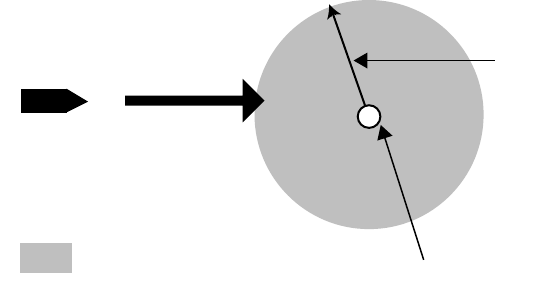
Chapter 2: Chart Plotter Operation
2-41
2.15 Alarms
This section covers the alarms available with the chart plotter:
• WPT arrival alarm
• Final arrival alarm
• XTE alarm
• Anchor watch alarm
• Proximity alarm
• Depth alarm
• Sea surface temperature alarm
• Sea surface temperature shear
• Speed alarm
• Trip log alarm
• Countdown timer
• Alarm clock
WPT Arrival Alarm
The arrival alarm informs you that your boat is approaching a waypoint. The area that
defines an arrival zone is that of a circle which you approach from the outside of the
circle. The audio and visual alarms will be released if your boat enters the circle. When
the arrival alarm is active a red dashed circle marks the arrival alarm area. Note that
the arrival alarm and anchor watch alarm can be turned on together.
Final Arrival Alarm
The final arrival alarm informs you when you are nearing your ultimate destination.
The area that defines the arrival zone is that of a circle which you approach from the
outside of the circle.
: Alarm area
Own ship
Alarm
range
Destination
waypoint
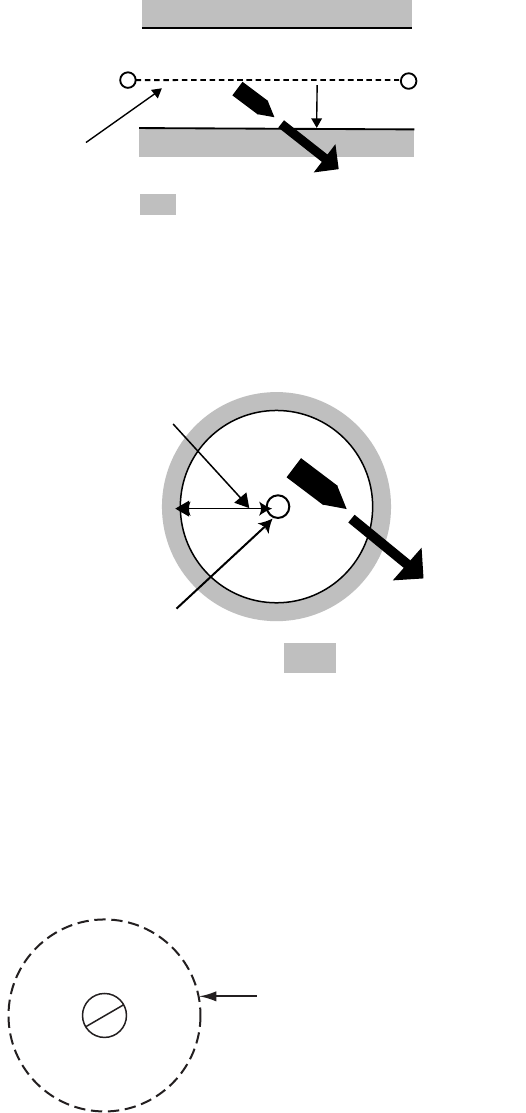
Chapter 2: Chart Plotter Operation
2-42
XTE Alarm
The XTE alarm warns you when your boat is off its intended course. When the XTE
alarm is active two red dashed lines mark the XTE alarm area.
Anchor Watch Alarm
The anchor watch alarm informs you that your boat is moving when it should be at rest.
When the anchor watch is active, a red dashed circle with an "X" at its center marks
the anchor watch area.
Proximity Alarm
The proximity alarm alerts you when own ship is nearing a point for which an avoid-
ance circle is active. When own ship is within the proximity distance set, audio and vi-
sual alarms are released.
Depth Alarm
The depth alarm sounds when the depth is within the depth alarm setting. To activate
the bottom alarm, the depth must be displayed.
: Alarm
Destination
waypoint
Own ship
position Alarm
setting
Intended
course
Your ship's position where
you start the anchor watch
alarm.
Alarm
setting
: Alarm
area
Proximity alarm marke
r
(red dashed circle)
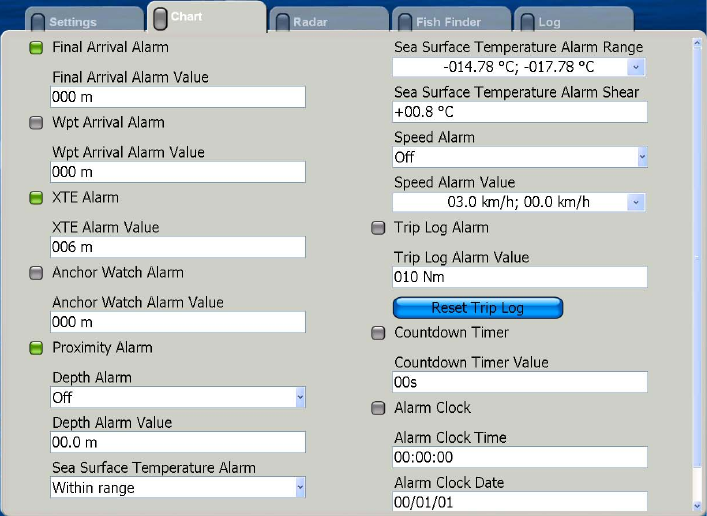
Chapter 2: Chart Plotter Operation
2-43
Sea Surface Temperature Alarm
There are three types of water temperature alarms: Within range, Out of range, and
Shear. The Within range alarm sounds when the water temperature is within the
range set.The Out of range alarm sounds when the water temperature is higher or
lower than the range set. The Shear alarm sounds when the temperature trend goes
higher or lower than set.
Speed Alarm
The speed alarm alerts you when your boat’s speed is within the range set, out of the
range set, higher than speed set, and under the speed set.
Trip Alarm
The trip alarm informs when you have travelled a certain distance.
Countdown Timer
The countdown timer lets the user keep track of how much of a pre-set period of time
remains.
Alarm Clock
The alarm clock works like an ordinary household alarm clock, releasing audio and vi-
sual alarms when the preset time comes.
Setting an Alarm
1. Press the MENU key to open the menu.
2. Open the Alarms menu.
3. Open the Chart sub menu.
4. With the cursor in the menu, rotate the Rotary Knob to select an alarm item.
5. Push the Rotary Knob to disable or enable the alarm; color the square green to
enable the alarm, or gray to disable it.
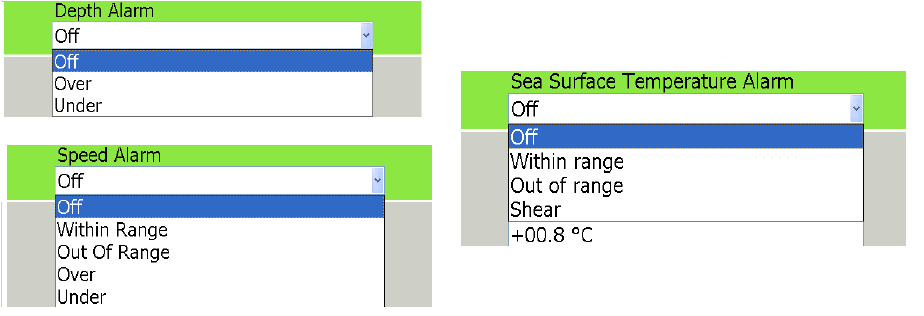
Chapter 2: Chart Plotter Operation
2-44
6. For the depth, speed and temperature alarms, do the following:
1)Select item’s combo box and push the Rotary Knob to show alarm types avail-
able.
2)Choose option desired and push the Rotary Knob.
7. Rotate the Rotary Knob to select the item’s Alarm Value box and push the Rotary
Knob.
8. Rotate the Rotary Knob to set value and push it to confirm setting.
9. Press the MENU key to close the menu.
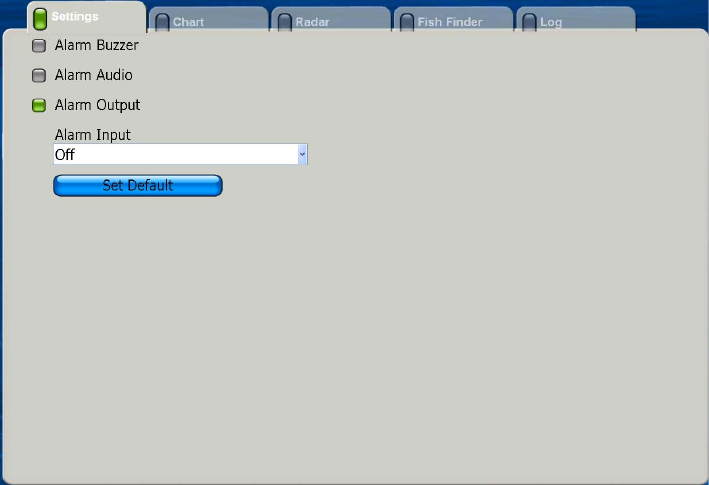
Chapter 2: Chart Plotter Operation
2-45
Alarm Audio Options
Audio and visual alarms are released when an alarm is violated. You can enable or
disable the audio buzzer as follows:
1. Press the MENU key to open the menu.
2. Open the Alarms menu.
3. Select the Settings sub menu.
4. Select Alarm Buzzer, Alarm Audio, Alarm Output as applicable and push the
Rotary Knob.
Alarm Buzzer: Enable or disable internal and external alarm buzzers.
Alarm Audio: Enable or disable audio output to external device.
Alarm Output: Use melody or alarm supplied by external playback device.
5. Press the MENU key to close the menu.
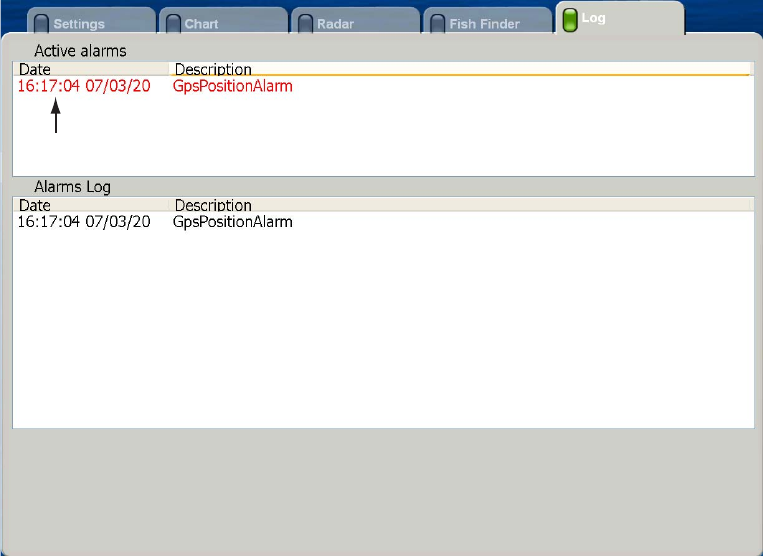
Chapter 2: Chart Plotter Operation
2-46
Alarm Log
The Alarm Log in the Alarm menu lists the name of active and past alarms and the
date and time they were violated. Refer to it to know what alarms have been violated.
Active alarm displayed in red

3-1
Chapter 3: Radar Operation
This chapter provides the information necessary for radar operation. A few of the top-
ics included are how to
• Adjust gain
• Suppress sea and rain clutter
• Measure range and bearing
• Suppress interference
• Stretch echoes
• Set a guard zone
• Interpret the radar display
3.1 Transmitting, Stand-by
When the power switch is turned on, the magnetron, the device in the antenna unit
which transmits radar pulses, starts warming up. Warm-up takes about one minute
and 30 seconds, and the timer at the center of the display counts down the time re-
maining for warming up. When the countdown reaches zero (0:00), ST-BY appears at
the screen center, indicating the radar is now ready for operation. To transmit, long-
push the GAIN/TX key. (This can also be done with the Tx ROTOkey.)
When you won’t need the radar for a long period, it is a good idea to set it in standby
to conserve the magnetron. Long-push the GAIN/TX key to toggle between transmit
and stand-by.
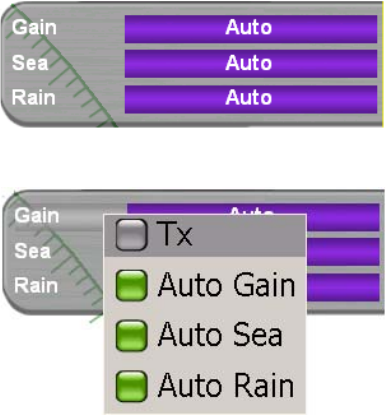
Chapter 3: Radar Operation
3-2
3.2 Adjusting the Gain
The GAIN/TX key adjusts the gain sensitivity of the radar receiver. It works in a man-
ner similar to that of volume control of a broadcast receiver, which amplifies received
signals.
The proper setting is such that the background noise is just visible on the screen. If
your gain setting is too low, weak echoes may be missed. On the other hand, exces-
sive gain yields too much background noise; strong targets may be missed because
of the poor contrast between desired echoes and the background noise on the display.
Gain can be adjusted automatically or manually and the default adjustment is auto-
matic. For manual adjustment do the following:
1. Put the cursor below the heading indication at the top right-hand corner on the
screen to show the Gain, Sea and Rain adjustment window.
2. Put the cursor on Gain and push the right-button key to show the pop-up menu.
3. Rotate the Rotary Knob to select Auto Gain and push the Rotary Knob to show
Auto Gain’s status box in gray.
4. Put the cursor on Gain to highlight it in green and push the left-button key in the
center of the Cursorpad.
5. Rotate the Rotary Knob to adjust the gain. The length of the bar increases or
decreases with rotation of the Rotary Knob.
6. Push the Rotary Knob to finish.
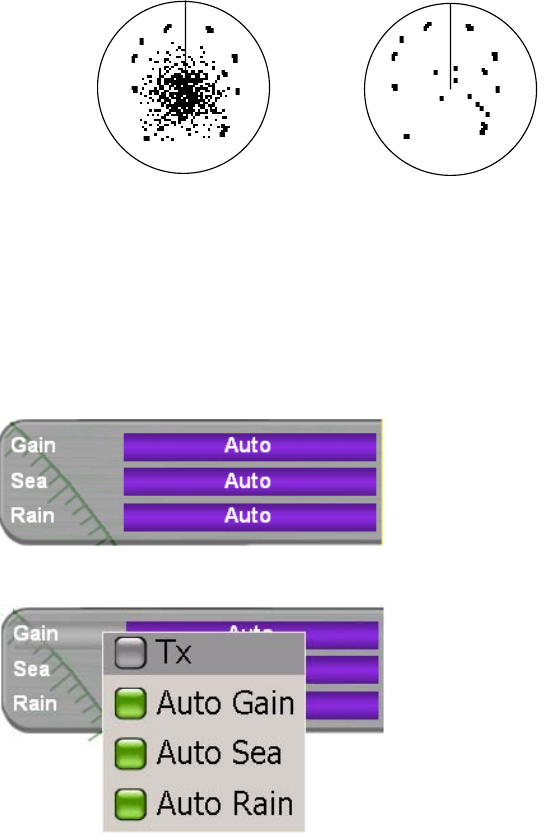
Chapter 3: Radar Operation
3-3
3.3 Suppressing Sea Clutter
Echoes from waves can be troublesome, covering the central part of the display with
random signals known as "sea clutter". The higher the waves and the higher the an-
tenna above the water, the further the clutter will extend. Sea clutter may affect radar
performance because real targets are sometimes hidden by the echoes of small
waves. (See the left-hand figure in the figure below.) When sea clutter masks the pic-
ture, adjust the Sea control to reduce the clutter.
Sea clutter can be suppressed automatically or manually and the default adjustment
method is automatic. For manual suppression do the following:
1. Put the cursor below the heading indication at the top right-hand corner on the
screen. The Gain, Sea and Rain adjustment window appears.
2. Put the cursor on Sea and push the right-button key to show the pop-up menu.
3. Rotate the Rotary Knob to select Auto Sea and push the Rotary Knob to show
Auto Sea’s status box in gray.
4. Put the cursor on Sea to highlight it in green and push the left-button key in the
center of the Cursorpad.
5. Rotate the Rotary Knob to suppress the sea clutter. The length of the bar
increases or decreases with rotation of the Rotary Knob.
6. Push the Rotary Knob to finish.
Sea control adjusted;
sea clutter suppressed
Sea clutter at
screen center
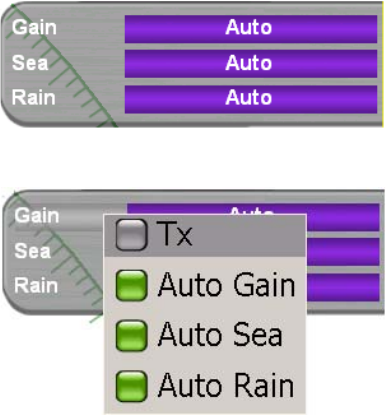
Chapter 3: Radar Operation
3-4
3.4 Suppressing Rain Clutter
The vertical beamwidth of the antenna is designed to see surface targets even when
the ship is rolling. However, by this design the unit will also detect rain clutter (rain,
snow, hail, etc.) in the same manner as normal targets. Rain clutter shows as random
dots on the screen.
When echoes from precipitation mask solid targets, adjust the Rain control to split up
these unwanted echoes into a speckled pattern, making recognition of solid targets
easier.
Rain clutter can be suppressed automatically or manually and the default adjustment
method is automatic. For manual suppression do the following:
1. Put the cursor below the heading indication at the top right-hand corner on the
screen. The Gain, Sea and Rain adjustment window appears.
2. Put the cursor on Rain and push the right-button key to show the pop-up menu.
3. Rotate the Rotary Knob to select Auto Rain and push the Rotary Knob to show
Auto Rain’s status box in gray.
4. Put the cursor on Rain to highlight it in green and push the left-button key in the
center of the Cursorpad.
5. Rotate the Rotary Knob to suppress the rain clutter. The length of the bar
increases or decreases with rotation of the Rotary Knob.
6. Push the Rotary Knob to finish.
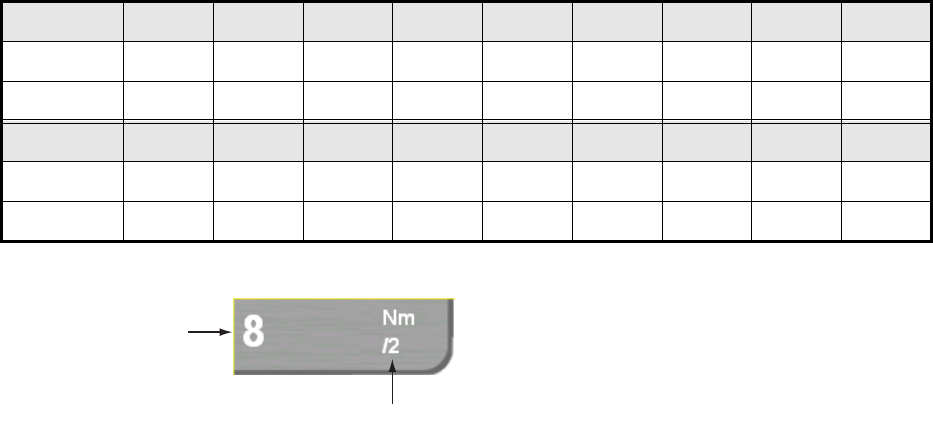
Chapter 3: Radar Operation
3-5
3.5 Range Scale
The range setting determines the size of the area (in nautical miles) that will appear
on your display. In addition, the range setting will also automatically adjust the range
ring interval so that accurate range measurements may be made while operating on
any range setting.
The range and range ring interval appear at the top left-hand corner of the display.
To select a range, use the RANGE key. Hit RANGE OUT to increase the range;
RANGE IN to decrease the range.
Alternatively, you can select a range with the Radar pop-up menu (access by right-
button key) or at the range indication. Below is the procedure for changing the range
from the range indication.
1. Put the cursor on the range indication and push the left-button key at the center
of the Cursorpad. The center of the range indication box turns green.
2. Rotate the Rotary Knob to select a range and then push the Rotary Knob.
Range (nm)
0.0625 0.125 0.25 0.5 0.75 1.0 1.5 2 3
Ring Interval
0.03125 0.0625 0.125 0.25 0.25 0.25 0.5 0.5 1
No. of Rings
222234343
Range (nm)
46812 16 24 36 48 64
Ring Interval
122346121216
No. of Rings
434444344
Range
Range ring interval
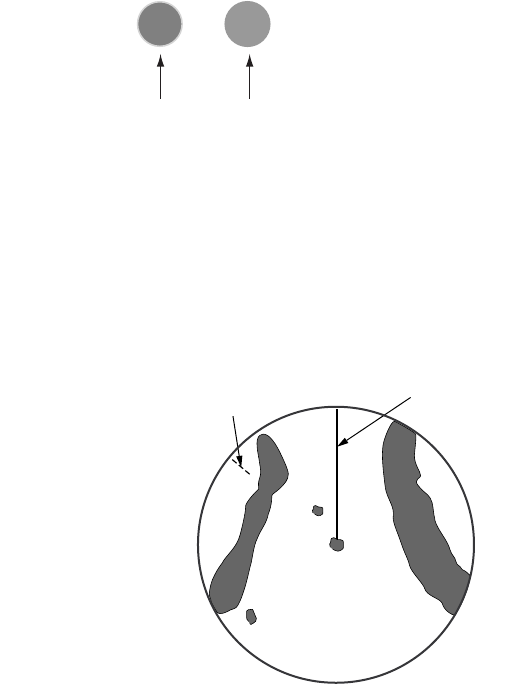
Chapter 3: Radar Operation
3-6
3.6 Presentation Mode
The presentation mode determines the relation between your boat and other targets,
moving and stationary.
Heading data is required in modes other than head-up. When heading data is lost, the
presentation mode automatically goes to head-up, and the compass icon has a red X
through it. Restore compass signal to show heading indication. Re-select presentation
mode if necessary.
To choose a presentation mode, put the cursor on the applicable presentation mode
icon at the left side of the screen and hit the left-button key at the center of the Cur-
sorpad.
Description of Presentation Modes
Head-up
A display without azimuth stabilization in which the line connecting the center with the
top of the display indicates own ship's heading. Targets are painted at their measured
distances and in their directions relative to own ship's heading. The short line on the
bearing scale is the north marke.
Motion modePresentation mode
NU RM
Heading Line
N
orth Marker
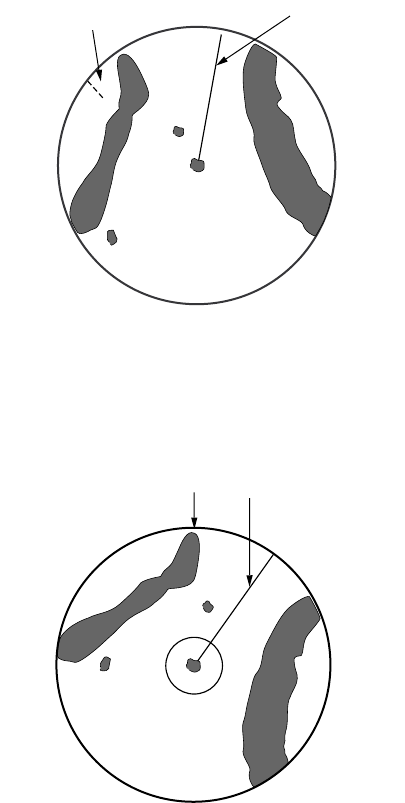
Chapter 3: Radar Operation
3-7
Course-up
The radar picture is stabilized and displayed with the currently selected course at the
top of the screen. As you change heading, the ship's heading line moves. If you select
a new course, the picture resets to display the new course at the top of the display.
Targets are painted at their measured distances and in their directions relative to the
intended course which is maintained at the 0-degree position. The heading line moves
in accordance with ship's yawing and course changes.
North-up
In the north-up mode, targets are painted at their measured distances and in their true
(compass) directions from own ship. North is maintained at the top of the screen. The
heading line changes its direction according to ship's heading.
Heading Line
North Marker
Heading Line
North
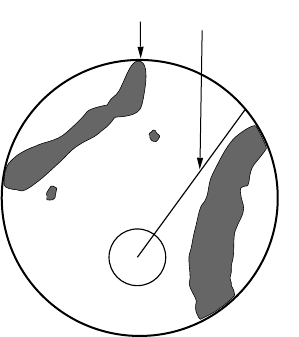
Chapter 3: Radar Operation
3-8
True motion
Fixed radar targets maintain a constant position on the screen, while your own ship
moves across the radar image at the correct speed and heading. A map-like image is
displayed, with all moving vessels traveling in true perspective to each other and to
fixed landmasses. As your ship's position approaches the edge of the screen, the ra-
dar display is automatically reset to reveal the area ahead of your ship. You can man-
ually reset your ship's position at any time by pressing the SHIP/3D button at the
center of the Scrollingpad.
Heading Line
North

Chapter 3: Radar Operation
3-9
3.7 Measuring the Range
You can measure the range to a radar target three ways: by the range rings, by the
cursor, and by the Variable Range Marker (VRM).
Use the fixed range rings to obtain a rough estimate of the range to a target. They are
the concentric solid circles about own ship, or the sweep origin. The number of rings
is automatically determined by the selected range scale and their interval is displayed
at the upper-left position of the screen. Count the number of rings between the center
of the display and the target. Check the range ring interval and judge the distance of
the echo from the inner edge of the nearest ring.
Displaying the Range Rings
If the rings are not displayed, press the right-button key to show the Radar pop-up
menu. Rotate the Rotary Knob to choose Rings and push the Rotary Knob to color the
status box green to turn on the range rings. (Range rings can also be turned on or off
with the Rings ROTOkey.)
Measuring Range with a VRM
There are two VRMs, No. 1 and No. 2, which appear as dashed rings so that you can
discriminate them from the fixed range rings. The two VRMs can be distinguished from
each other by different lengths of dashes. The coarse dashed ring is the No. 1 VRM
and the fine dashed one is the No. 2 VRM.
The control box for the VRMs is hidden unless a VRM is active or the cursor is placed
at the control box location. To show this box to measure the range to a target, follow
the procedure below. Note that you can also enable and disable an EBL with the EBL
ROTOkeys.
1. Put the cursor at the bottom right-hand corner on the display to show the VRM
box.
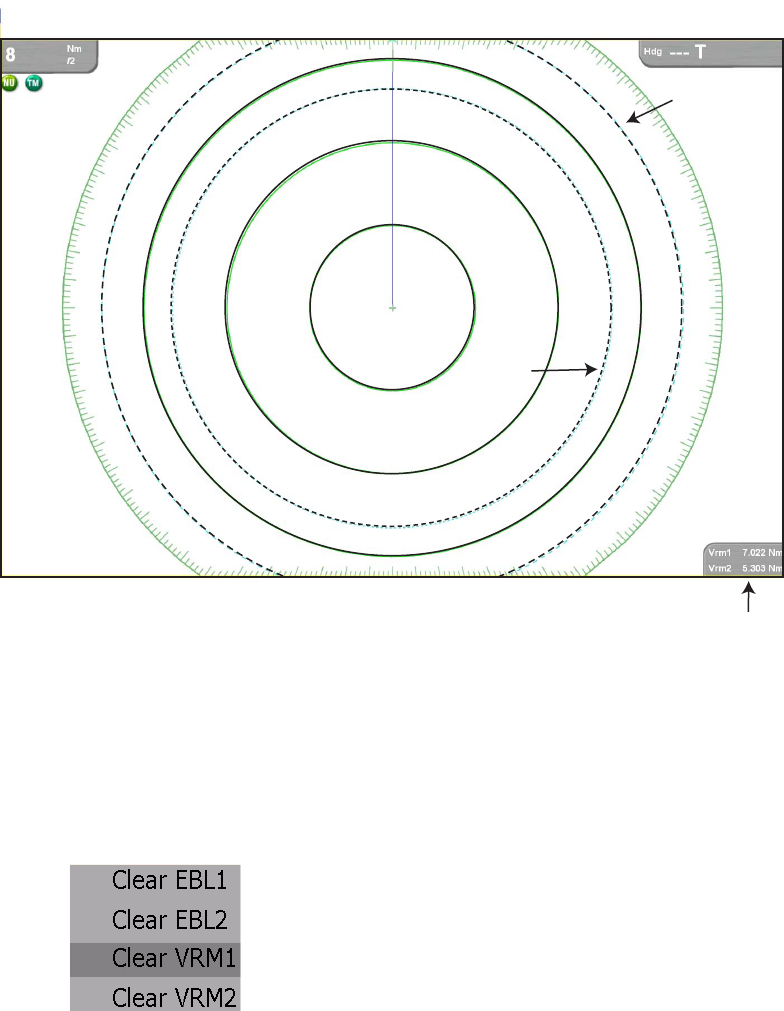
Chapter 3: Radar Operation
3-10
2. Put the cursor on Vrm1 or Vrm2 in the box, whichever you want to use, and push
the left-button key in the center of the Cursorpad.
Vrm1 (or Vrm2) and its indication are highlighted in green if properly selected.
Selected VRM appears outside the display area.
3. Rotate the Rotary Knob to place the VRM on the inner edge of the target.
4. Read the range to the target at the VRM box.
5. Push the Rotary Knob to finish. The VRM is then anchored at the range selected.
Erasing a VRM
To erase the VRM and its indication, follow the procedure below. Note that a VRM can
also be erased with the VRM ROTOkeys.
1. Put the cursor on a VRM indication in the VRM box and push the left-button key.
2. Push the right-button key to show the EBL/VRM pop-up menu.
3. Rotate the Rotary Knob to select the VRM to erase and push the Rotary Knob.
The VRM and its indication are erased.
VRM1
VRM2
VRM box
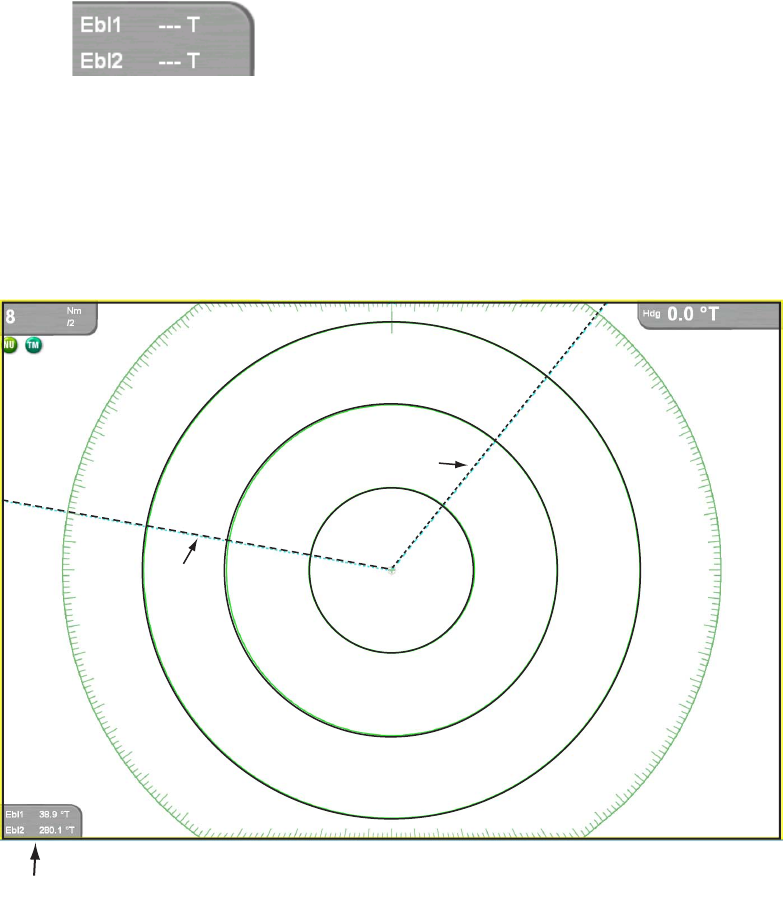
Chapter 3: Radar Operation
3-11
3.8 Measuring Bearing
There are two ways to measure the bearing to a target: by the cursor, and by the Elec-
tronic Bearing Line (EBL).
Measuring Bearing with an EBL
There are two EBLs, No. 1 and No. 2. Each EBL is a straight dashed line extending
from the own ship position to the edge of the screen. The coarse dashed line is the
No. 1 EBL and the fine dashed one is the No. 2 EBL.
The control box for the EBLs is hidden unless an EBL is active or the cursor is placed
at the control box location. To show the box to measure the bearing to a target, follow
the procedure below. Note that you can also enable and disable an EBL with the EBL
ROTOkey.
1. Put the cursor at the bottom left-hand corner on the display to show the EBL box.
(Above the data boxes if they are currently displayed.)
2. Put the cursor on Ebl1 or Ebl2 in the box, whichever you want to use, and push
the left-button key in the center of the Cursorpad to display that EBL.
Ebl1 (or Ebl2) and its indication are highlighted in green if properly selected.
3. Rotate the Rotary Knob to bisect the target with the EBL.
4. Read the range to the target at the EBL box.
5. Push the Rotary Knob to finish. The EBL is then anchored at the bearing selected.
EBL2
EBL1
EBL box
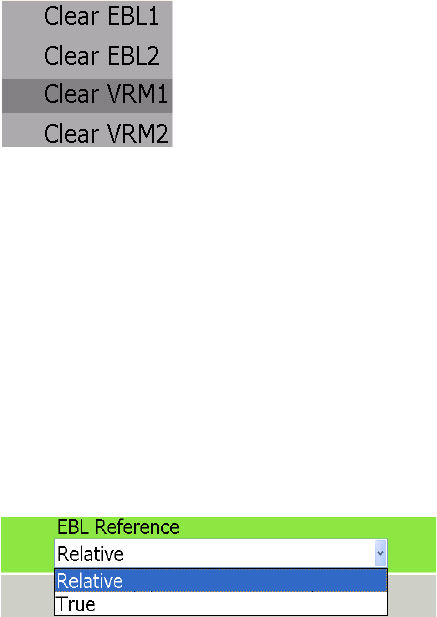
Chapter 3: Radar Operation
3-12
Erasing an EBL
To erase an EBL and its indication, follow the procedure below. Note that an EBL can
also be erased with the EBL ROTOkeys.
1. Put the cursor on the EBL indication to process and push the left-button key.
2. Push the right-button key to show the EBL/VRM pop-up menu.
3. Rotate the Rotary Knob to select the EBL to erase and push the Rotary Knob.
The EBL and its indication are erased.
Selecting true or relative bearing
The EBL readout is affixed by "R" (relative) if it is relative to own ship's heading, "T."
(true) if it is referenced to the north. You may choose relative or true in the head-up
modes; in all other modes it is always TRUE.
1. Press the MENU key to open the menu.
2. Open the Radar menu.
3. Select EBL Reference and push the Rotary Knob.
4. Select Relative or True as applicable and push the Rotary Knob.
5. Press the MENU key to close the menu.
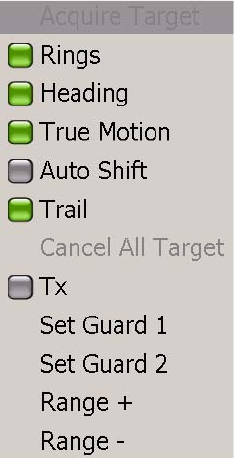
Chapter 3: Radar Operation
3-13
3.9 Erasing the Heading Line, North Marker
The heading line indicates the ship's heading in all presentation modes. It is a line from
the own ship position to the outer edge of the radar display area and appears at zero
degrees on the bearing scale in head-up mode; it changes its orientation in the north-
up, course-up and true motion modes with ship's movement.
The north marker appears as a short dashed line. In the head-up and course-up
modes the north marker moves around the bearing scale as the ship's heading moves.
To temporarily erase the heading line and north marker:
1. Put the cursor somewhere not occupied by a context-sensitive item and push the
right-button key. The Radar pop-up menu appears.
2. Select Heading and push the Rotary Knob to turn the heading line on or off.
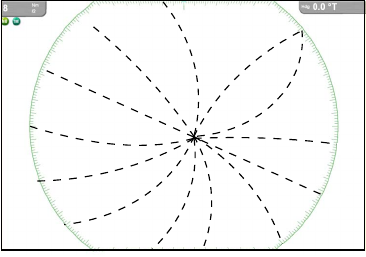
Chapter 3: Radar Operation
3-14
3.10 Reducing Radar Interference
Radar interference may occur when near another shipborne radar that is operating in
the same frequency band as your radar. Its on-screen appearance looks like many
bright dots either scattered at random or in the form of dotted lines extending from the
center to the edge of the display. Interference effects are distinguishable from normal
echoes because they do not appear in the same place on successive rotations of the
antenna.
Be sure to turn off the interference rejector when no interference exists - weak targets
may be missed.
To turn the interference rejector on or off:
1. Long-push the Rotary Knob.
2. Select the Process ROTOkey and push the Rotary Knob.
3. Select the Int. Rej. ROTOkey and push the Rotary Knob.
The indication "IR" appears at the left side of the screen when the interference rejector
is on.
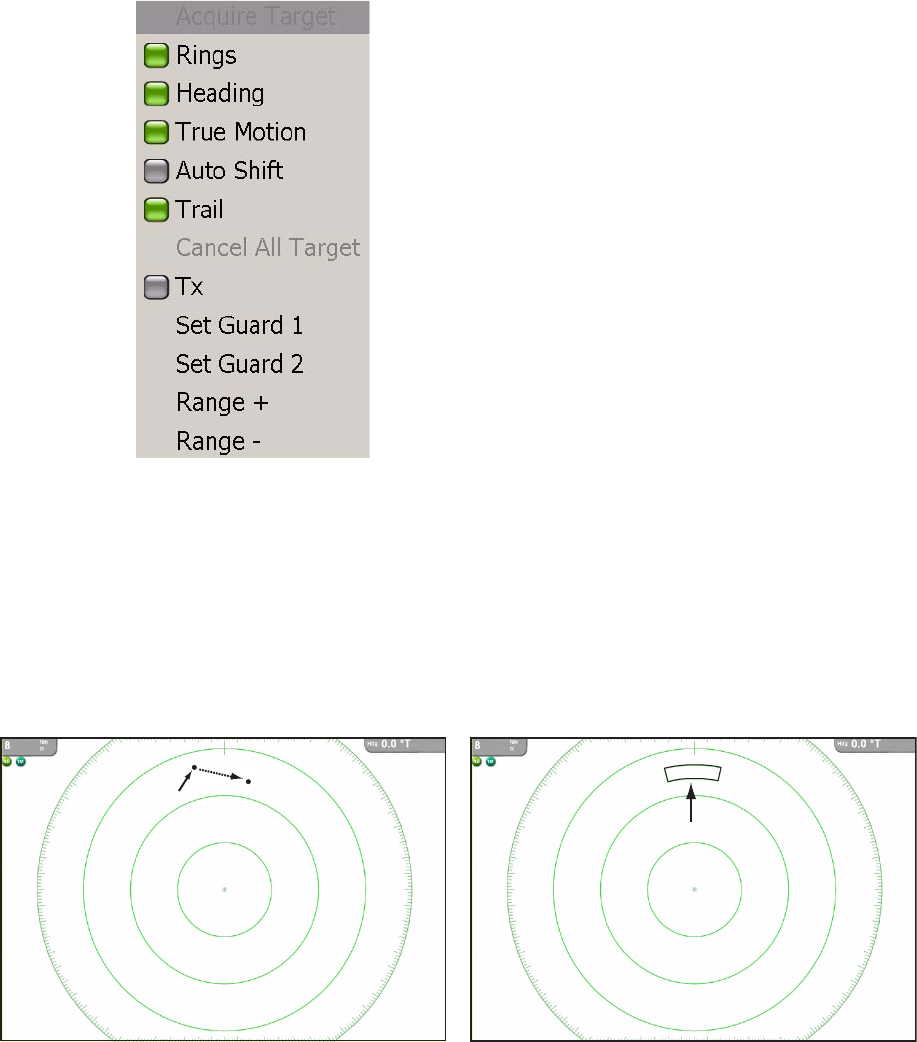
Chapter 3: Radar Operation
3-15
3.11 Guard Zone
The purpose of a guard zone is to provide audio and visual alerts against targets
(ships, islands, landmasses, etc.) entering a specific area.
Setting a Guard Zone
1. Push the right-button key to show the Radar pop-up menu.
2. Rotate the Rotary Knob to choose Set Guard 1 or Set Guard 2, whichever you
want to set, and push the Rotary Knob. The point placement cursor appears at
cursor location.
3. Use the Cursorpad to put the point placement cursor at the top left corner for the
guard zone (Point A below).
4. Press the left-button key in the center of the Cursorpad.
5. Use the Cursorpad to drag the point placement cursor to the bottom right corner
(Point B below) for the guard zone and push the left-button key.
Acknowledging Guard Zone
When a target enters the area, the buzzer sounds (default) and the offending target
blinks to call the operator's attention. The buzzer may be silenced with the CANCEL
key. I
Point A
Point B
Drag cursor to Point B
Guard Zone
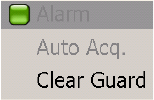
Chapter 3: Radar Operation
3-16
Clearing a Guard Zone
1. Put the cursor on a line of the guard zone and press the left-button key in the
center of the Cursorpad. The line becomes thicker if correctly selected.
2. Rotate the Rotary Knob to select Clear Guard and push the Rotary Knob.
Enabling, Disabling Audio Alarm
The audio alarm sounds when a radar target enter the guard zone. If you do not need
the audio alarm you can disable it on the Settings sub menu of the Radar menu.
1. Press the MENU key to open the menu.
2. Open the Radar menu.
3. Open the Settings sub menu.
4. Turn Echo Guard Alarm on or off as appropriate.
5. Press the MENU key to close the menu.
3.12 Proximity Target Alarm
This alarm alerts you, with audio and visual alarms, when you are nearing an AIS tar-
get by the range set here.
1. Press the MENU key to open the menu.
2. Open the Alarm menu.
3. Open the Radar sub menu.
4. Select Proximity Target Alarm.
5. Push the Rotary Knob to color the status box green.
6. Select Proximity Target Value and push the Rotary Knob.
7. Rotate the Rotary Knob to set the one and tens place and push the Rotary Knob.
8. Rotate the Rotary Knob to set the tenths place and push the Rotary Knob.
9. Press the MENU key to close the menu.
To disable the alarm, color the status box gray at step 5 and close the menu.
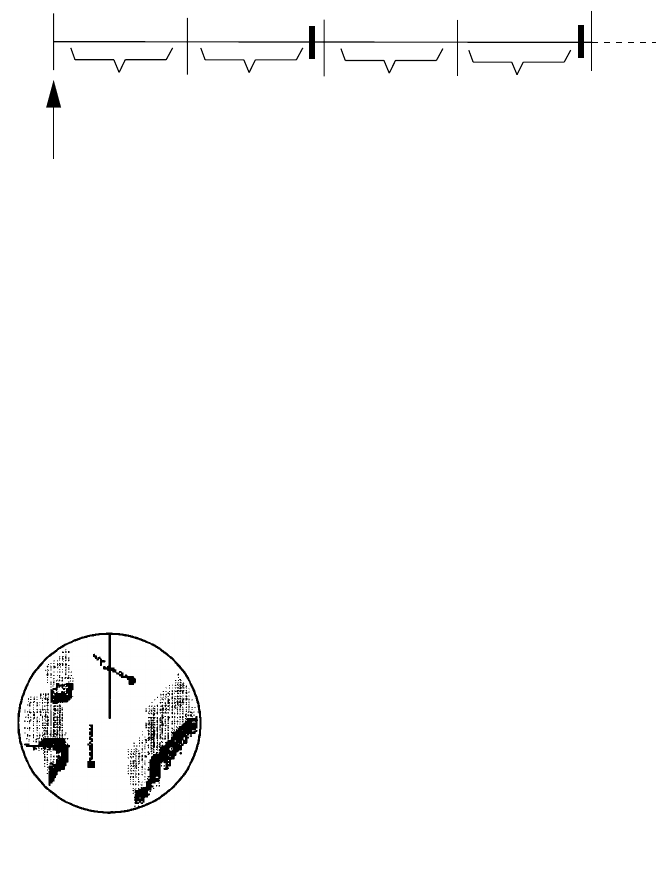
Chapter 3: Radar Operation
3-17
3.13 Watchman
The watchman function periodically transmits radar pulses for one minute to check for
targets in a guard zone. If a target is found in the zone, watchman is cancelled, the
audio alarm sounds and the radar continues transmitting. If no target is found the radar
goes into standby for the number of minutes specified on the RADAR DISPLAY SET-
UP menu. This feature is useful when you do not need the radar's function continu-
ously but want to be alerted to radar targets in a specific area. "WTCH" appears on
the display when Watchman is active.
1. Set a guard zone, referring to section 3.11. (Watchman is inoperative unless a
guard zone is active.)
2. Long-push the Rotary Knob to show the ROTOkeys.
3. Rotate the Rotary Knob to choose Watchman and push the Rotary Knob.
4. Choose desired interval and push the Rotary Knob.
3.14 Echo Trails
Echo trails are simulated afterglow of target echoes that represent their movements
relative or true to own ship. This function is useful for alerting you past possible colli-
sion situations.
To turn the trails on or off:
1. Long-push the Rotary Knob to show the ROTOkeys.
2. Select the Trail ROTOkey and push the Rotary Knob to turn trails on or off as
desired.
To clear trails to restart new trails:
1. Long-push the Rotary Knob to show the ROTOkeys.
2. Select the Clear Trail ROTOkey and push the Rotary Knob to restart trails.
ST-BY
5,10
or
20 min
Tx
1 min
Tx
1 min
Watchman
starts
5,10
or
20 min
ST-BY
**
* Beeps emitted just before radar transmits.
Relative target trails
Targets moving relative
to own ship
Chapter 3: Radar Operation
3-18
3.15 Echo Stretch
Normally, the reflected echoes from long range targets appear on the display as weak-
er and smaller blips even though they are compensated by the radar's internal circuit-
ry. The echo stretch function magnifies these small blips in all ranges.
This function magnifies not only targets but also sea clutter and radar interference. For
this reason, be sure sea clutter and radar interference are properly suppressed before
activating the echo stretch.
To turn the echo stretch on or off:
1. Long-push the Rotary Knob.
2. Select the Process ROTOkey and push the Rotary Knob.
3. Select the Stretch ROTOkey and push the Rotary Knob.
3.16 Echo Average
The echo average feature effectively suppresses sea clutter. Echoes received from
stable targets such as ships appear on the screen at almost the same position during
every rotation of the antenna. On the other hand, unstable echoes such as sea clutter
appear at random positions.
To distinguish real target echoes from sea clutter, echo average performs scan-to-
scan correlation. Correlation is made by storing and averaging echo signals over suc-
cessive picture frames. If an echo is solid and stable, it is presented in its normal in-
tensity. Sea clutter is averaged over successive scans resulting in the reduced
brilliance, making it easier to discriminate real targets from sea clutter.
To turn the echo average on or off:
1. Long-push the Rotary Knob.
2. Select the Process ROTOkey and push the Rotary Knob.
3. Select the Average ROTOkey and push the Rotary Knob.

Chapter 3: Radar Operation
3-19
3.17 Automatic Offcenter
Own ship position, or sweep origin, can be displaced automatically to expand the view
field without switching to a larger scale.
The amount of automatic offcenter is calculated according to ship's speed, and the
amount of offcenter is limited to 50% of the range in use. For example, if you set the
offcenter speed setting for 15 knots and the ship is running at 10 knots the amount of
offcenter will be about 34%. The formula for determining offcenter amount is as shown
below. Automatic offcenter mode is only available in the head-up mode.
Setting Offcenter Speed
1. Press the MENU key to open the menu.
2. Open the Radar menu.
3. Choose Offcenter Speed and push the Rotary Knob.
4. Enter auto offcenter speed to use and then push the Rotary Knob.
5. Press the MENU key to close the menu.
Enabling, Disabling Auto Offcenter
1. Long-push the Rotary Knob.
2. Choose the Offcenter ROTOkey and push the Rotary Knob to alternately enable
and disable auto offcenter.
3.18 Wiper
The wiper feature automatically suppresses the brilliance of weak signals (noise, sea
clutter, rain clutter, etc.) and unwanted signals such as radar interference to clear the
picture of unwanted echoes. Use this when unwanted echoes cannot be suppressed
by other methods.
1. Press the MENU key to open the menu.
2. Open the Radar menu.
3. Select Wiper and push the Rotary Knob to turn the wiper feature on or off as
desired.
4. Press the MENU key to close the menu.
Ship's speed
Offcenter speed settin
g
X 0.5 = Amount of offcenter(%)
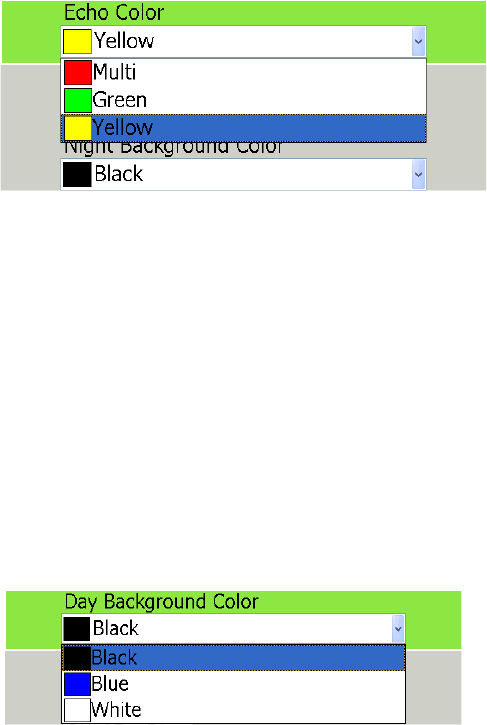
Chapter 3: Radar Operation
3-20
3.19 Echo Color
Echo color is available in single colors of yellow and green, or multi-color. Multi-color
paints echoes in colors from red, green and yellow in order of ascending echo
strength.
1. Press the MENU key to open the menu.
2. Open the Radar menu.
3. Choose Echo Color and push the Rotary Knob.
4. Choose color desired and push the Rotary Knob.
5. Press the MENU key to close the menu.
3.20 Background Color
The background color can be changed for daytime and nighttime operations. Automat-
ic selection is available when Day/Night Mode in the Settings sub menu of the General
menu is set for Automatic, the default setting.
1. Press the MENU key to open the menu.
2. Open the Radar menu.
3. Choose Day Background Color and push the Rotary Knob.
4. Choose color desired and push the Rotary Knob.
5. Choose the color for Night Background Color similarly.
6. Press the MENU key to close the menu.

Chapter 3: Radar Operation
3-21
3.21 Displaying Own Ship Icon
In the default setup, current position on the radar display is marked with a plus mark
( ). If you would like to show it with the boat icon, the configuration of which is set on
the Settings sub menu in the General menu, do the following:
1. Press the MENU key to open the menu.
2. Open the Radar menu.
3. Choose Own Ship Icon.
4. Push the Rotary Knob to turn the icon on or off.
5. Press the MENU key to close the menu.
3.22 Radar Overlay Automatic Range
In the default setting, the range of all multi function displays in the NavNet 3D network
is changed whenever the range is changed. If you would prefer to set range indepen-
dently, turn off the radar overlay automatic range feature.
1. Press the MENU key to open the menu.
2. Open the Radar menu.
3. Choose Radar Overlay Automatic Range.
4. Push the Rotary Knob to color the status box green for ON, or gray for OFF.
5. Press the MENU key to close the menu.
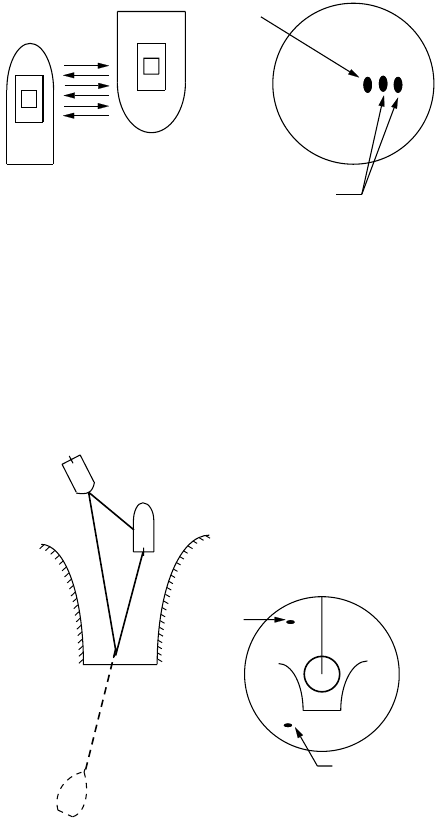
Chapter 3: Radar Operation
3-22
3.23 Interpreting the Radar Display
False Echoes
Occasionally echo signals appear on the screen at positions where there is no target
or disappear even if there are targets. False target situations may be recognized, how-
ever, if you understand why they are displayed. Typical false echoes are shown below.
Multiple echoes
Multiple echoes occur when a transmitted pulse returns from a solid object like a large
ship, bridge, or breakwater. A second, a third or more echoes may be observed on the
display at double, triple or other multiples of the actual range of the target as shown
below. Multiple reflection echoes can be reduced and often removed by decreasing
the gain (sensitivity) or properly adjusting the SEA control.
Virtual image
A relatively large target close to your ship may show at two positions on the screen.
One of them is the true echo directly reflected by the target and the other is a false
echo which is caused by the mirror effect of a large object on or close to your ship as
shown in the figure below. If your ship comes close to a large metal bridge, for exam-
ple, such a false echo may temporarily be seen on the screen.
Own ship
Target
True
echo
Multiple
echo
True
echo
False
echo
Own
ship
Target ship
Mirror image
of target ship
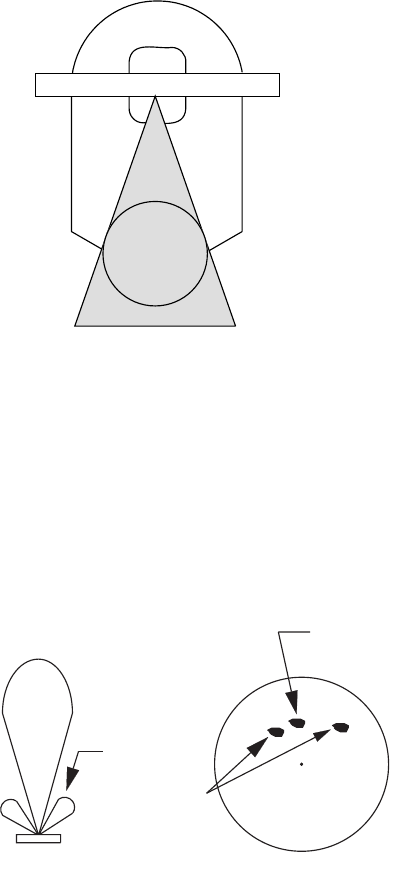
Chapter 3: Radar Operation
3-23
Shadow sector
Funnels, stacks, masts, or derricks in the path of the antenna block the radar beam. If
the angle subtended at the antenna is more than a few degrees, a non-detecting sec-
tor or blind spot may be produced. Within this sector, targets can not be detected.
Sidelobe echoes
Every time the radar pulse is transmitted, some radiation escapes on each side of the
beam. This stray RF is called a "sidelobe." If a target exists where it can be detected
by the sidelobes as well as the main lobe, the side echoes may be represented on both
sides of the true echo at the same range. Sidelobes show usually only on short ranges
and from strong targets. They can be reduced through careful reduction of the gain or
proper adjustment of the Sea control.
Radar
antenna
Radar
mast
Shadow sector
Spurious
target
True echo
Main-lobe
Side-lobe
Antenna
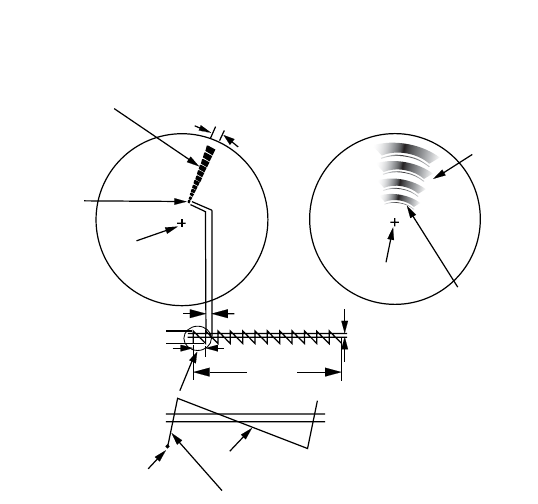
Chapter 3: Radar Operation
3-24
Search and Rescue Transponder (SART)
A SART may be triggered by any X-Band (3 cm) radar within a range of approximately
8 nm. Each radar pulse received causes it to transmit a response which is swept re-
petitively across the complete radar frequency band. When interrogated, it first
sweeps rapidly (0.4 ms) through the band before beginning a relatively slow sweep
(7.5 ms) through the band back to the starting frequency. This process is repeated for
a total of twelve complete cycles. At some point in each sweep, the SART frequency
will match that of the interrogating radar and be within the pass band of the radar re-
ceiver. If the SART is within range, the frequency match during each of the 12 slow
sweeps will produce a response on the radar display, thus a line of 12 dots equally
spaced by about 0.64 nautical miles will be shown.
When the range to the SART is reduced to about 1 nm, the radar display may show
also the 12 responses generated during the fast sweeps. These additional dot re-
sponses, which also are equally spaced by 0.64 nm, will be interspersed with the orig-
inal line of 12 dots. They will appear slightly weaker and smaller than the original dots.
General procedure for detecting SART response
1. Use the range scale of 6 or 12 nm as the spacing between the SART responses is
about 0.6 nm (1125 m) to distinguish the SART.
2. Turn off the automatic clutter suppression.
3. Turn off the Interference Rejector.
9500 MHz
9200 MHz
Radar antenna
beamwidth
Screen A: When SART
is distant
Screen B: When SART
is close
Lines of 12
dots are
displayed in
concentric
Echo from SART
Position of
SART
Own ship
position Own ship
position
SART mark
length Radar receiver
bandwidth
Sweep time
7.5 μs
95 μs
Sweep start Hi
g
h speed sweep si
g
nal
Low speed sweep signal
24 NM 1.5 NM
Position of
SART
Echo from
SART
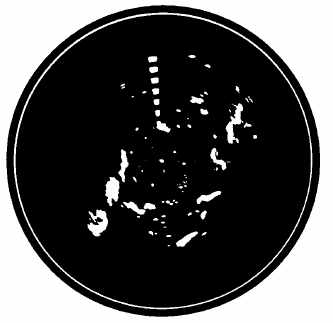
Chapter 3: Radar Operation
3-25
Racon (Radar Beacon)
A racon is a radar transponder which emits a characteristic signal when triggered by
a ship's radar (usually only the 3 centimeter band). The signal may be emitted on the
same frequency as that of the triggering radar, in which case it is superimposed on the
ship's radar display automatically.
The racon signal appears on the PPI as a radial line originating at a point just beyond
the position of the radar beacon or as a Morse code signal (see figure below) dis-
played radially from just beyond the beacon.
Chapter 3: Radar Operation
3-26
This page intentionally left blank.